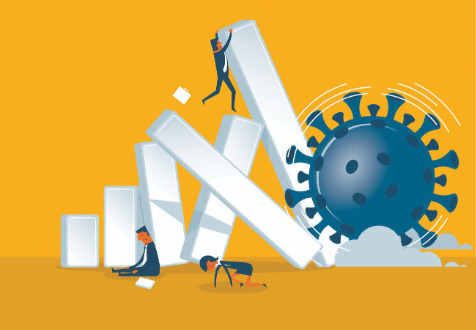Rocky road to recovery
Though initial indications post-unlock phase have been positive, sustaining the momentum of this post-Covid economic recovery in India is likely to be a monumental task

The fact that the Indian economy will fare badly this financial year is a given. That it could quickly turn around is also not a surprise either. But then, sustaining an incipient recovery would be the biggest challenge. And this would be a financial sector marvel.
The first-quarter GDP numbers were a shocker. Against the broad estimates of some dent, the figures revealed a massive shrinkage of a quarter.
The draconian shutdown from March 22 to the middle of June had completely halted large sections of the economy like railway movements, airlines functioning, ports and shipping and services sectors, not to talk of manufacturing which at any rate was struggling. Power generation, which is an essential service, had also been drastically affected.
Since then, with the process of gradual unlocking, things have started moving already. Some of the established private estimates like PMIs are showing a hefty lift at 58.9, which is said to be the highest in the last several years. Any PMI above the level of 50 is an indication of growth.
Manufacturing industries are also growing, although these could be the result of the sheer base effect. That is, with things grinding to a halt, any restart will be shown as a jump. With the traditional festive season already upon us, the demand for consumer goods industries — both durable and non-durables — are getting buoyant.
But in the current situation, the most critical sector would be the farm and rural economy. Since the Covid outbreak in the country, we are already about to enter a second agriculture cycle. Farm products prices are high currently. Three items particularly, potato, onion and tomato, prices are at record levels of around Rs 100 per kg.
This had two conflicting implications. One is that there is some income creation in the farmers' hands and that the food demand is buoyant. But then, shooting food articles' inflation could constrict policy options before the Government and the Reserve Bank.
The October-end harvests are about to enter the market and one can expect these prices to stabilise now. Since a large part of the Indian economy remains small and informal, their agility is also high. They can resume operations much faster than organised large-scale units. It appears that the smaller informal sector is again moving forward.
Thus, the real economy of agriculture and industry are showing some dynamism and movement. But there are serious causes for concern. While incipient economic recovery could have started, sustaining these trends would be critical. There could be two challenges in this effort.
First is that the disease should be checked and contained. It should not be let spread like what is happening in the rest of the world (like in Europe and the USA). The incidence of the disease has been crippling. At least nine months of ravaging spread has given us some insights into its behaviour and patterns. There is consensus that wide-spread and compulsory use of face-masks in public places, social distancing norms and personal hygiene could check the wild-fire.
Secondly, the diseases had hurt the physical economy directly and grievously. The organised sectors could be somewhat protected from the ill-effects by freezing their financial burden for a limited period. Now that the loan repayment moratorium periods are coming to an end and repayments obligations would start, there should be ways of meeting these.
How would the industry meet its financial obligations without fully recovering from the impact of the pandemic? Most companies and institutions still do not have the wherewithal to start repaying their accumulated loans and other dues.
So credit flow is a must for retaining the recovery momentum. How banks and non-banking financial companies, which provide critical bridge finance to many sectors, are enabled to maintain the credit line.
These financial intermediaries have already been under stress. The Indian banking sector has had a burgeoning bad debts portfolio. More loans getting sticky could, in the next stage, cripple the banks and NBFCs.
Already the fears of the current economic recession from the pandemic morphing into a financial crisis have been raised. MS Carmen Reinhart, one of the most respected economists specialising in financial crises, who is now the Chief Economist of the World Bank, has raised this issue.
If this is an issue flagged for the global economy, it is already on our hands in India. The burden of carrying bad debts and the need for their resolution had been alive since the days of former RBI Governor, Raghuram Rajan. A series of steps have been initiated to address the question of bad debts. These included restricting the banks having the largest bad debt portfolios from granting fresh loans. Many of these restrictive moves have been suspended for the time being since the Covid outbreak. But now, the conflicting demands would have to be resolved.
It appears that in the near term, keeping the recovery story intact should not be difficult out of sheer dynamics of demand and restarting the stalled activities. But the real problem will be to resolve the inner contradictions of the financial sector. We have to keep the credit flow intact, at the same time keep the viability of the banks and NBFCs. It will be the problem of ensuring enough credit expansion and finding money for that while addressing the viability of banks and financial institutions.
An integral part of this exercise would be to provide additional capital for these institutions. Being in the public sector, major Indian banks must be adequately capitalised by one other than the Government. That will be the requirements at least for the immediate future. How do we make that sure thing in the current framework of an extremely stretched fiscal situation?
Views expressed are personal



